
Public Reading as Resistance
by Kelly Hussey-Smith and Marnie Badham
.......................................................
As this 2024 edition of Unlikely is themed 'Resistance,' we acknowledge that many of our art and academic peers have been silenced for raising their voices as resistance to the genocide in Gaza. We stand in solidarity with these censored voices and urge others to join the call for an immediate ceasefire in Gaza. We stand with Palestinian and First Peoples around the world impacted by the ongoing oppressive regimes of settler-colonialism.
- View Kelly Hussey-Smith's Biography
Kelly Hussey-Smith is a creative researcher focused on photography as a social practice and art education and is a Senior Lecturer in Photography in the School of Art at RMIT University.
- View Marnie Badham's Biography
Marnie Badham is a social practice artist-researcher in Canada and Australia and Associate Professor at RMIT University.
Public Reading as Resistance
Kelly Hussey-Smith and Marnie Badham

Screen grab from an AI generated Microsoft Viva email
Driving home from a three-day self-organised research retreat with fellow artists and activists, we discussed our dread at the expected backlog of emails and upcoming meetings awaiting our return. Kelly had recently commenced a full-time employment contract at the university but expressed concern that so far, academic life had consisted of rushed meetings and distracting bureaucracy, leaving the work of teaching and research to take place outside of paid hours. Marnie disclosed her shame at the towering stack of unopened books on her desk that needed to be read for her current research projects. We playfully considered scheduling time for scholarly reading in our calendars as a response to the bureaucratic cultures that dominate our time as academics. While our students are familiar with the fast-paced choreographies of our academic work, we suspect that they had never seen us read a book. Here, among what we might consider the ruins of our academic desires and labour, Public Reading as Resistance first found its form.
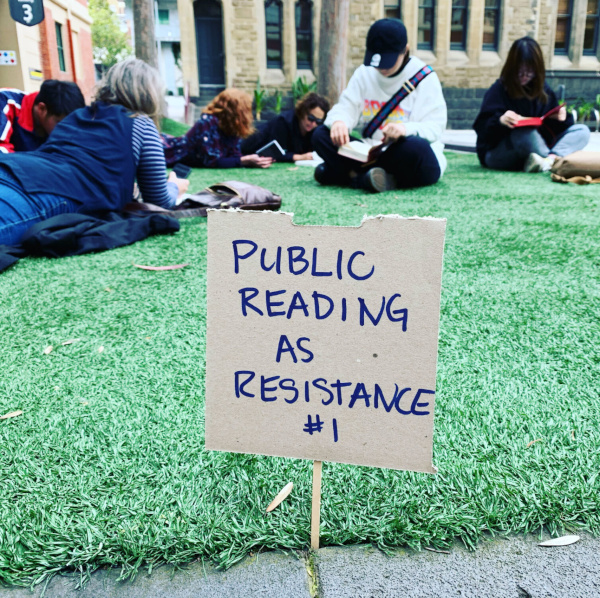
Public Reading as Resistance #1, Bowen Lane, Naarm/Melbourne. Image credit: ceri hann.
Shortly after our discussion in the car, we gathered with a small group of students and colleagues on the Bowen Street astro turf at RMIT University for the first Public Reading as Resistance event. Armed with books carefully chosen and sourced from our offices and studios — and a makeshift tiny sign crafted from recycled cardboard with a popsicle stick attached to the back — we came together to read in public during the lunch hour of a regular workday. Those who attended the event had received a meeting invitation through the university's Microsoft Outlook calendar system to join us in a collective response to the shared experience of exhaustion, distraction, and a waning sense of purpose in everyday academic life (Fleming 2021; Ahmed 2021). Taking this institutionalisation as the site and subject of our gentle activism, we used the combination of bodies and books together in public space, and the tactic of the 'calendar meeting' to draw attention to the value of reading.
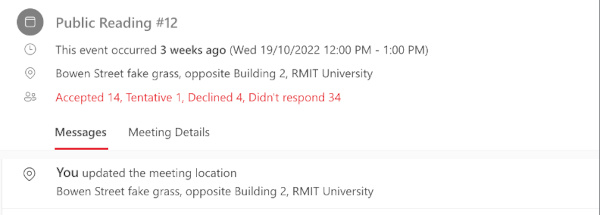
Microsoft Calendar Invitation for Public Reading as Resistance #12, screen grab
Academic Performance
As a performative social engagement project, Public Reading draws attention to the contradictions that exist in contemporary academic life in Australian universities by designing new orientations and socialites through this performative collective action. Described by Peter Fleming as an "obedience to bureaucratic authority" (2021, 40), the work life of the contemporary academic is largely shaped by a sense of corporate inertia that supplants the rigour and surprise of academic work (Sedgwick 2003), with the corporate culture of meetings, evaluation, and measurement. In this culture, only that which can be measured is considered valuable and therefore rendered visible as 'real work' within the university (Gielen 2013). Even communication technologies like email, where we spend much of our time, now measure and make comment on our productivity. As we see in the screen grabs below, the Artificial Intelligence generated wellbeing reports have the veneer of helping to improve work life balance — but the responsibility to do this is individualised and the time to organise this 'balance' must also be scheduled.

Marnie's personalised Microsoft Outlook productivity report, screen grab
Key Performance Indicators (otherwise known as KPIs), excessive administration, professional goal setting, incessant working groups, and the constant pursuit of research funding leave scant time for the core work of teaching, research collaboration, and interdisciplinary dialogue. Instead, our calendars are filled with meetings and committees, planning sessions, required compliance training, and the pressures of grant and reporting deadlines. As a band aid for the lack of administrative support, the glorification of overwork, and the normalisation of academic burnout, the university (or rather, it is often Microsoft Viva) now offers life coaching, counselling, and wellbeing seminars that address the problem at an individual level. Even tennis great Maria Sharapova has a visualisation practice to share with us in response to 'setbacks'. This individualised form of neoliberal 'care' not only contributes to our workloads, but also ensures dissent takes place behind closed doors (Ahmed 2021).
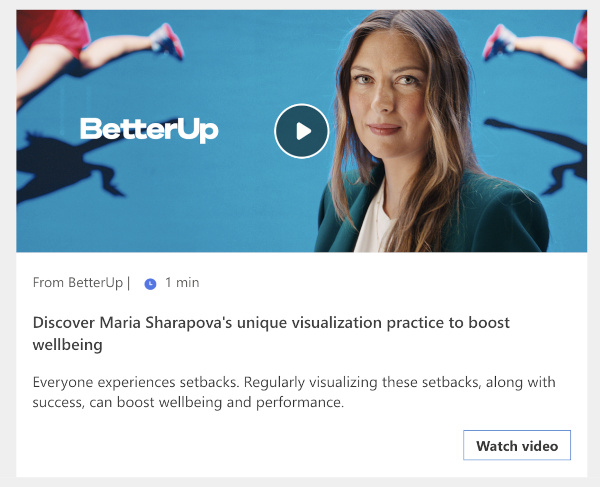
Wellbeing initiatives and tips from Microsoft Viva digest email, screen grab
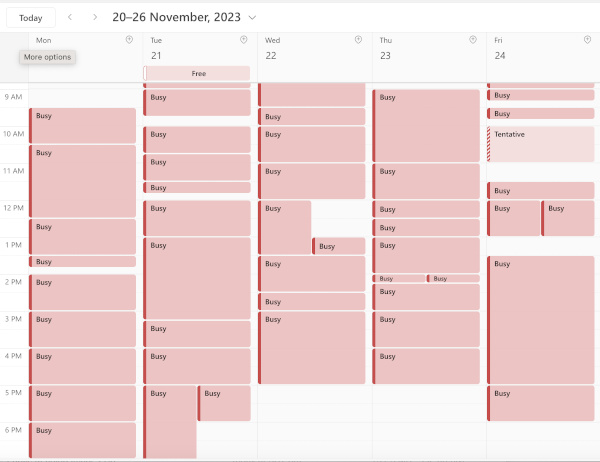
User view of Marnie's staff calendar for one week in October 2023, screen grab
Despite the playful nature of Public Reading, our creative and collective response to the current state of academia is not a naïve or a nostalgic longing for a university of the 'past'. Decolonial scholars consistently emphasise the academy's complicity in the ongoing colonial agenda (Smith 2021; Tuck and Yang 2014). This is exacerbated by the emphasis on the narrow determinants of 'employability' emphasised through a turn to vocational education that de-historicise and neutralise 'professional' practices and industries from their historical, critical and cultural lineages and discourses. Instead of a 'return to' a romanticised past, we hope for a 'turn to' a less emaciated academic culture where transpersonal relations and collective learning are integral to academic life (Goodman 2021); education and research are understood as generative spaces of ethical engagement; and knowledge production is framed as a civil practice for our shared world (Azoulay 2015). Despite this ongoing legacy, we remain problematically and sentimentally committed to the university as Eve Tuck and K. Wayne Yang put it, as "one of the last places for legitimated enquiry" (2014, 223).
Public Reading as Resistance is this angst and hope manifested in a public gesture, where we collectively dare to benefit from the learning and scholarly activities that persuaded us to invest in universities in the first place. By employing the aesthetics of protest to generate dialogue and activate community between colleagues and the wider academic community who, by their own admission, are also overloaded and burnt out, we perform the contradictions we feel in our academic lives. With the social contract between executive management and academic employees under increased strain (Connell 2019; Russell 2020) reading in public during regular work hours feels almost transgressive. It is in this immeasurable place of 'study' as Fred Moten and Stefano Harney (2013) explain that we experience the rhythms, choreographies, and socialites of what our academic work cultures could be.
The resistance must be scheduled!
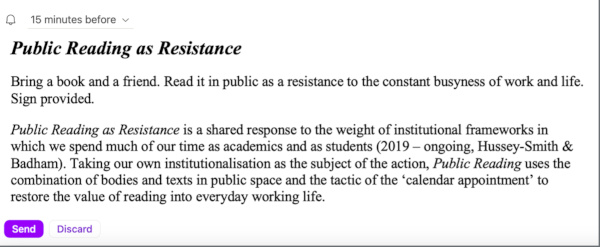
Public Reading as Resistance Microsoft Outlook calendar invite, screen grab
Sitting together for one-hour one late morning on a Wednesday, a small group of students and staff sat down to quietly read. This initial group of eager readers accepted the Microsoft Outlook invitation delivered the day before. There was great care taken in choosing our readings for this inaugural reading session — some from our office bookshelves while others took a special trip to the campus library. These 'public readers' considered: What are the books that are most relevant to our action? Which book did we want to show others? Books about public space, love and community, art as political action, urban planning, social inclusion, feminist care networks, and public pedagogy have all attended Public Reading as Resistance. Many of us commented on the joy and nostalgia of holding the weight and materiality of a book in our hands — a tangible counterpoint to the experience of reading on screens.
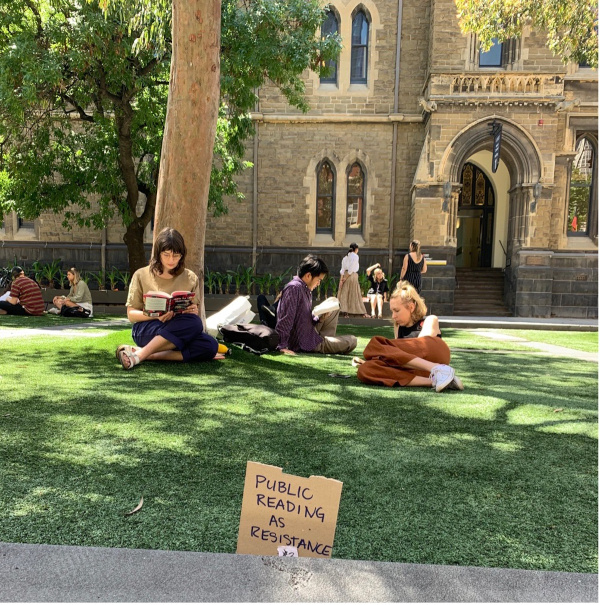
Public Reading as Resistance #3, Bowen Lane, Naarm/Melbourne. Image credit: Marnie Badham.
Introductions for those who didn't know each other and the proud sharing of book covers around the circle slowly settled us into our reading. It was a typical chilly spring day in Melbourne, but the sun warmed our backs while curiosity slowed many of the people walking by. Once they could read the tiny sign, some colleagues sped up their walking pace and looked away, refusing to acknowledge our earnest action. Others looked at us with sincere interest and curiosity. While not intended as a spectacle, the public gathering created for our passers-by appeared somewhat out of the ordinary. Students and staff sitting together cross-legged or lying down, immersed in our individual books (rather than devices like laptops or smart phones) was unfamiliar especially during work hours. We endured the urge to break our concentration and relied instead on the tiny sign to communicate our aim.
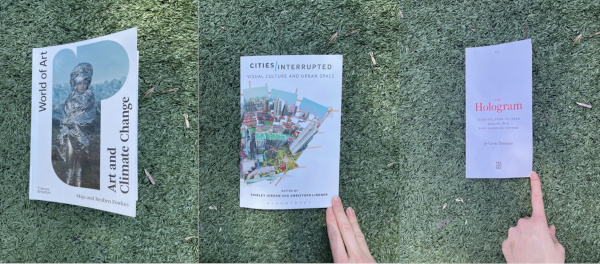
Some of the books read at Public Reading as Resistance #12, Bowen Lane, Naarm/Melbourne. Image credit: Kelly Hussey-Smith.
Each subsequent time we hosted Public Reading as Resistance, our Microsoft Outlook invitation circulated to a larger network expanding from the inaugural three to thirty readers across the tenure of the project. We were initially nervous to 'spam' people who may not share our institutional critique; however, we quickly realised the calendar invitation was a key tactic for both subversive experimentation and registering attention through its odd ability to request the attendance of absolutely anyone! By subversively reclaiming our 'tools', we playfully hijacked the language of institutional authority.
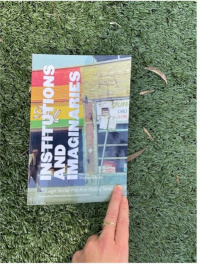
One of the books read at Public Reading as Resistance #12, Bowen Lane, Naarm/Melbourne, Image credit: Kelly Hussey-Smith.
We strategically targeted peers whom we thought could benefit from self-reflection on their own workloads and rhythms. Some invitees responded enthusiastically to the concept but declined the invitation because they were 'too busy'. Others shared more specifically about what their calendar conflict was. Committee meetings over lunch, working from home, and spiralling workloads were all cited as valid reasons why our invitations had been declined. Some sent a personalised apology to us through 'reply all', others consistently clicked 'tentative' but never attended, and others gave no response.
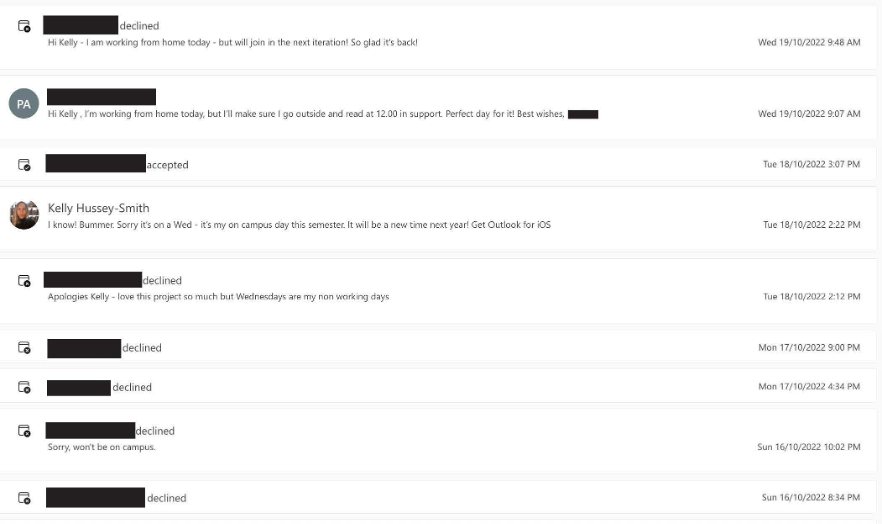
Colleagues declining the calendar invite for Public Reading as Resistance, screen grab
Public Reading as Resistance continued weekly and then fortnightly across the warmer months of 2019 through to early 2020. Depending on weather conditions and teaching schedules, the group developed its own rhythms and scale. The size of the group did not matter to us, but admittedly it felt more comfortable to have company. Kelly staged Public Reading by herself one day with the tiny sign and book in hand. No one else showed up for the first forty minutes, so she sat alone reading as commitment to our small act of resistance. For another regular Wednesday session, the group blew out to over thirty 'public readers' from different academic disciplines including professional staff from a range of schools across the university. Some had looked forward to the session so much so that they prepared a special lunch, put on sunscreen and a hat, or brought outdoor lounge chairs for comfort.
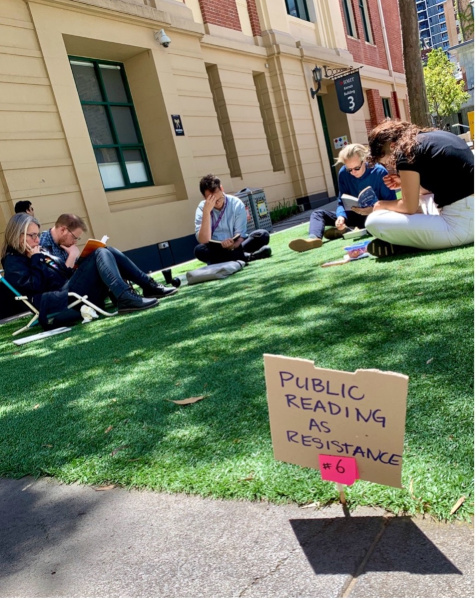
Public Reading as Resistance #6, Bowen Lane, RMIT University, Naarm/Melbourne. Image credit: Marnie Badham.
At Public Reading as Resistance #10, an enthusiastic newcomer voiced their confusion, not understanding how such a gentle act could function as resistance. When do we protest? Do we make a parade and chant together? Should we make some noise, so they hear our concerns? Although this reader shared our concerns with the over-bureaucratisation of academic life, they expected a more overt and spectacular form of protest. Instead, we just read our books together with the tiny sign.
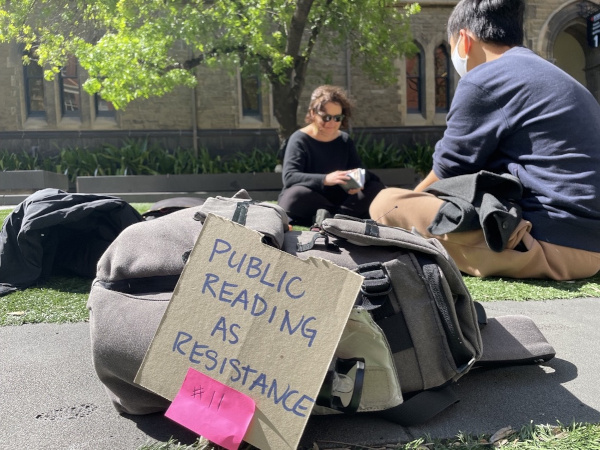
Public Reading as Resistance #11, Bowen Lane, RMIT University, Naarm/Melbourne. Image credit: Marnie Badham.
A post graduate student also challenged our provocation at one session, asking why we need to protest the university. They reported enjoying reading as a core activity of their daily life during their PhD candidature. They rejected the term 'resistance,' suggesting it was overused and clichéd. Some other academics in the group reflected on the gap between the dedication and enthusiasm of the student in comparison with what they felt was an often-emaciated academic life. Many who attended admitted that they struggle to read new material in their disciplinary fields, let alone find time to develop new thinking. Another reader brainstormed an idea for an event slogan 'no outputs without inputs' in relation to the institutional quantification of our teaching and research. Someone else queried why music wasn't playing and another reader reported they had skipped the previous session as they didn't want to 'run into' someone they thought might be in attendance. Another colleague joined us for the first time with enthusiasm but expressed their shame as they had printed off reading for a PhD milestone review. They realised that others were not doing 'work'. Public Reading as Resistance had quickly become a multivalent space for dialogue through the registering of varying concerns and contradictions of institutional life.
Our simple provocation of Public Reading as Resistance includes a few simple elements: the calendar invites and replies, the convivial public action of reading together, critical reflection and dialogue about our institutional work lives and the 'spin offs' for those who became implicated through engagement, refusal, ignorance, or solidarity in other ways.
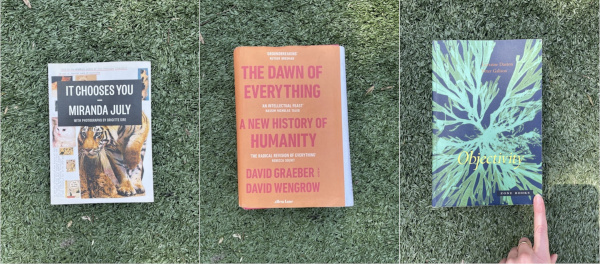
Some of the books read at Public Reading as Resistance #12, Bowen Lane, Naarm/Melbourne. Image credit: Kelly Hussey-Smith.
When Public Reading as Resistance returned in October 2022, after close to two years of lockdowns in Naarm, we saw the most diverse group of readers across the thirteen installations so far. First year photography students, public art postgraduate students, PhD candidates, ongoing and sessional academic staff, and managers and Associate Deans participated in the action.
By embracing its performative and contradictory nature — including various critiques that it is nothing more than posturing, ruined by the sign, lacking impact, appropriates activist aesthetics, and is generally ineffective as a form of resistance — we locate the strength of Public Reading as Resistance. We embrace the productive tensions of its absurdity, and even its failure to change our conditions and habits. As Sara Ahmed reminds us, "rubbing up against the institution is the way one comes to know it" (2012, 28). As such, our 'rubbing against' produced both a warmth and friction that has enabled new forms of public sociality to emerge.
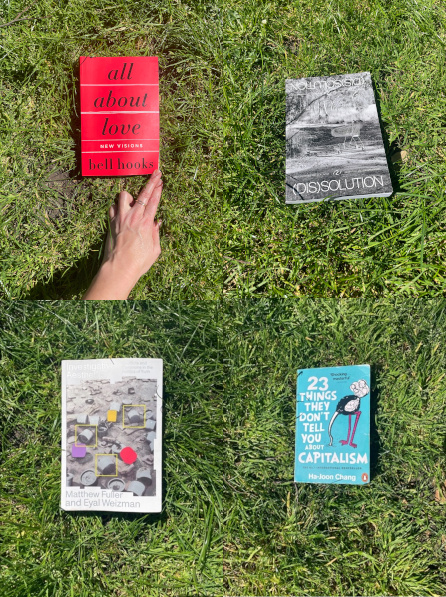
Public Reading as Resistance #13, Edinburgh Gardens, Naarm/Melbourne. Image credit: Kelly Hussey-Smith.
As a durational project, Public Reading as Resistance continues to make visible the conditions of the university through the simple provocation of reading together during work hours outdoors on university grounds. It continues to create new relationalities between colleagues and has served to nurture intergenerational solidarities on the question of what should constitute academic work.
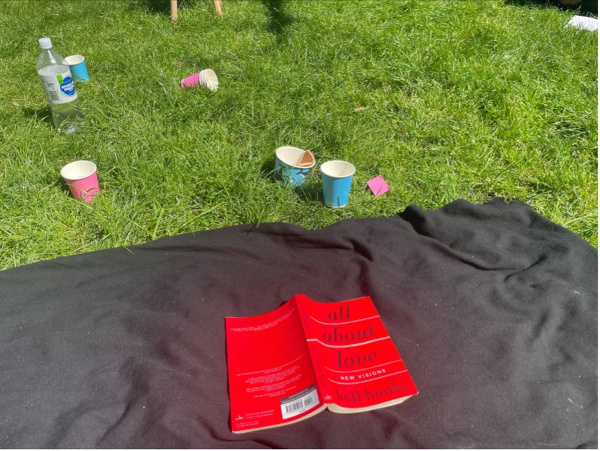
Public Reading as Resistance #13, detail, Edinburgh Gardens, Naarm/Melbourne. Image credit: Kelly Hussey-Smith.
Through this rubbing up against our institutional contexts and acknowledging our collective exhaustion, we actively recognise the conditions in which we work. As a project, Public Reading as Resistance not only draws attention to these conditions but creates space to enjoy the nourishment of its merits — comradery, intellectual engagement, and the forms of relationality that are typically are the first to disappear in corporate approaches to academia. In pointing out the obvious — that the university has become an absurd theatre, and us its loyal performers — our project hides in plain sight.
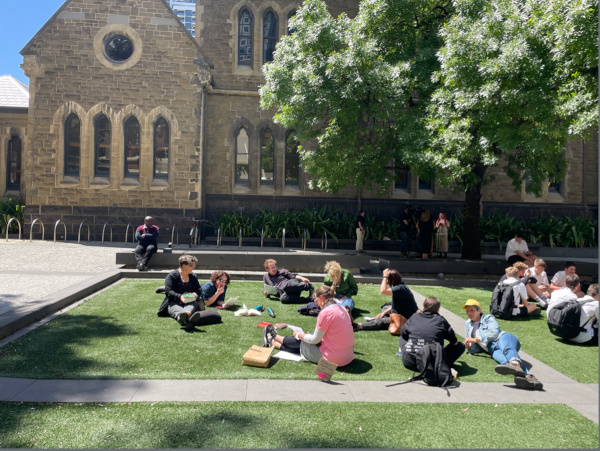
Public Reading as Resistance #12, Bowen Lane, RMIT University, Naarm/Melbourne. Image credit: Kelly Hussey-Smith.
Works Cited
Ahmed, S., 2021. Complaint! Duke University Press.
Azoulay, A.A., 2015. Civil imagination: A political ontology of photography. Verso Books.
Connell, R., 2019. The good university: What universities actually do and why it's time for radical change. Bloomsbury Publishing.
Fleming, P., 2021. Dark Academia How Universities Die. Pluto Press.
Gielen, P., 2013. Institutional attitudes: instituting art in a flat world. Valiz.
Goodman, A., 2021. 12 Care-full reading. Care Ethics and Art.
Harney, S. and Moten, F., 2013. The Undercommons: Fugitive planning and black study, Minor Compositions, Wivenhoe.
Russell, G., 2020. The Good University: What Universities Actually Do and Why it's Time for Radical Change. Australian Humanities Review, (66), pp. 1-1.
Sedgwick, E. K., 2003. Touching Feeling: Affect, Pedagogy, Performativity. Duke University Press.se
Smith, L. T., 2021. Decolonizing methodologies: Research and indigenous peoples. Bloomsbury Publishing.
Tuck, E. and Yang, K.W., 2014. R-words: Refusing research. Humanizing research: Decolonizing qualitative inquiry with youth and communities, pp. 223-248.

